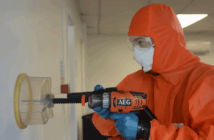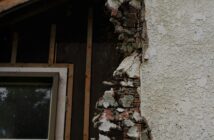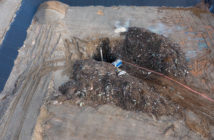Some of the most common construction and manufacturing jobs can create high levels of hazardous dust. WorkSafe offers excellent guidance for PCBU on how to choose, use and maintain industrial vacuums and portable extractors for controlling hazardous dust at work

If you decide to use industrial vacuums and portable extractors for controlling hazardous dust, this guidance will help you understand how to select and use these devices safely.
Risks presented by breathing in hazardous dust
Breathing in hazardous dust can cause diseases such as:
- lung or upper respiratory tract cancers
- chronic obstructive pulmonary disease (COPD)
- asbestos related diseases
- silicosis (including accelerated and acute silicosis).
Choosing the right type
Industrial vacuums and portable dust extractors used for hazardous dusts must be fit for purpose. This is to make sure the dust is safely captured and contained.
Domestic-rated, or standard commercial vacuums, do not provide a suitable level of protection against hazardous dust. These types of vacuums should not be used in industrial environments, regardless of the type of filter fitted.
Note: High-efficiency particulate air (HEPA) does not mean H-class.
Industrial vacuums rated for use with hazardous dusts are classed L, M or H. These letters refer to the hazard rating: light, medium, or high hazard.
M-class and H-class vacuums have safety features which include:
- the safe removal of dust collection bags
- an alarm indicator if the airflow falls below 20 cubic metres per second
- prevention of accidental opening and release of dust when not in use.
An H-class vacuum is required for managing dust exposures in the engineered stone benchtop industry as well as the removal of respirable crystalline silica (RCS) and dusts that may contain RCS. H-class industrial vacuums are also required for the removal of asbestos contaminated dust and debris
In the unlikely instance it is not reasonably practicable to use an H-class industrial vacuum, you should undertake a robust health risk assessment to support this decision. This should include an assessment of current control measures, personal exposure monitoring, and the frequency and duration of exposure.
Selecting the right class of filter
Filters for use with hazardous dusts are classified according to their filtration efficiency. Filters must:
- be designed to fit the model of vacuum cleaner you are using
- achieve the same filtration efficiency the vacuum cleaner is rated for (or higher).
For example, if the work requires use of an H-class industrial vacuum cleaner, you will need a filter that has the appropriate level of filtration efficiency.
Maintaining your industrial vacuum
Industrial vacuums should be maintained according to the manufacturers’ guidance. When cleaning your vacuum, you should:
- wear personal protective equipment (PPE) as required, including appropriate respirators (which have been fit-tested to ensure a good seal around the face)
- seal or cordon off an appropriate area to prevent unnecessary dust exposure to others
- make sure the dust bag has been removed and
disposed of first - use a damp cloth to clean the dust off the outside of your vacuum, and any inside parts you can access
- dispose of dust and containment bags and contaminated damp cloths appropriately and in tightly sealed bags or containers.
For a more thorough clean you can also clean it using another industrial vacuum cleaner. Only use this method if the other vacuum cleaner is rated at the same class, or higher.
Dry brushing or using compressed air should never be used to clean vacuums. These methods cause hazardous dust to spread and become airborne. Compressed air can also damage filters, making them ineffective.
Fit-testing for respirators should be conducted by a competent person. For more information on fit-testing, see Respiratory Protective Equipment (RPE)
Note: Where the industrial vacuum has been used for asbestos, removal and disposal of the
disposal sites. Check with your local authority on where these are and any requirements they may have.
Information and training
Workers must be provided with information, instruction, and training on how to use industrial vacuum cleaners. Workers should also understand:
- the types of hazardous dusts they are working with, and the associated health effects
- that hazardous dusts should never be removed using compressed air or dry sweeping methods
- why a particular class of vacuum cleaner has been selected
- the type of filter required for the class of vacuum cleaner being used
- the maintenance and testing requirements of the vacuum cleaner
- how to safely transport vacuum cleaners contaminated by hazardous dust
- how to dispose of waste appropriately.
Capturing dust from power tools
When using industrial vacuum cleaners, or on-tool dust extraction systems, the following considerations should be made:
- make sure the machine has sufficient power and capacity to keep up with the amount of dust, and the speed at which it is generated
- where the tool ejects material, such as in rotational cutting or grinding, make sure appropriate dust collection shrouds, hoods and guards are used, and placed effectively
- for power tools connected to dust extraction, select systems where dust extraction starts automatically when the tool is switched on
- for heavy dust loads, an in-line dust separator (cyclone) between the tool and the filter, can help extend the life of the filter.
Hazardous dust and specialist advice
The Table provides guidance on the hazardous dust class of materials or substances. The WorkSafe New Zealand special guide Workplace exposure standards and biological exposure indices should be used as a source of WES-TWA1 when determining the class of hazardous dusts.
A competent person may assist you in making these interpretations. A competent person is regarded as a person who has acquired through training, qualification or experience, the knowledge and skills to carry out a specific task.
Where specialist assistance is required, a competent person, such as those listed on the HASANZ Register may be able to help you.
More information
Guidance from WorkSafe:
Local exhaust ventilation
Silica dust in the workplace
Wood dust: controlling the risk
What you should know about working with asbestos
Hazardous waste
Health and exposure monitoring
Providing information, training, instruction or supervision for workers



